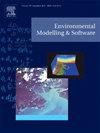A prototype adaptive mesh generator for enhancing computational efficiency and accuracy in physically-based modeling of flood-landslide hazards
IF 4.8
2区 环境科学与生态学
Q1 COMPUTER SCIENCE, INTERDISCIPLINARY APPLICATIONS
引用次数: 0
Abstract
Predicting landslides across large regions using physically-based models requires balancing computational accuracy and efficiency. Current methods often use limited resolutions, underutilizing available data. We present a prototype mesh generator that manages multiple resolutions in grid-based modeling frameworks, focusing on identifying likely landslide initiation points and conditionally stable pixels as meshing criteria. The generator refines critical locations using finer grids based on set parameters and is integrated into a coupled hydrological-geotechnical framework that combines one-dimensional (1D) and three-dimensional (3D) slope stability models. This framework operates on non-uniform grids and adaptively applies 1D or 3D models according to local accuracy requirements. Testing in the upper Han River basin, China (∼ ), during the July 2010 floods and landslides demonstrated that the mesh generator enhances landslide prediction, and the combined 1D-3D approach outperforms the standalone 1D model. This prototype shows promise for large-scale flood-landslide forecast systems.
一种用于提高洪水滑坡灾害物理建模计算效率和准确性的自适应网格生成器原型
使用基于物理的模型预测大面积滑坡需要平衡计算精度和效率。目前的方法通常使用有限的分辨率,未充分利用现有数据。我们提出了一个原型网格生成器,它在基于网格的建模框架中管理多个分辨率,重点是识别可能的滑坡起始点和有条件稳定的像素作为网格划分标准。该发生器根据设定的参数使用更精细的网格来细化关键位置,并集成到结合一维(1D)和三维(3D)边坡稳定模型的耦合水文-岩土框架中。该框架在非均匀网格上运行,并根据局部精度要求自适应应用1D或3D模型。在2010年7月中国汉江上游流域(约105平方公里)的洪水和滑坡期间进行的测试表明,网格生成器增强了滑坡预测,并且结合1D- 3d方法优于单独的1D模型。这个原型显示了大规模洪水滑坡预报系统的前景。
本文章由计算机程序翻译,如有差异,请以英文原文为准。
求助全文
约1分钟内获得全文
求助全文
来源期刊

Environmental Modelling & Software
工程技术-工程:环境
CiteScore
9.30
自引率
8.20%
发文量
241
审稿时长
60 days
期刊介绍:
Environmental Modelling & Software publishes contributions, in the form of research articles, reviews and short communications, on recent advances in environmental modelling and/or software. The aim is to improve our capacity to represent, understand, predict or manage the behaviour of environmental systems at all practical scales, and to communicate those improvements to a wide scientific and professional audience.
 求助内容:
求助内容: 应助结果提醒方式:
应助结果提醒方式:


